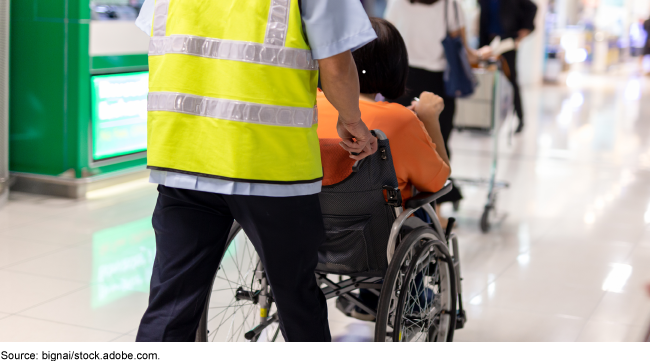Passengers with Disabilities: Barriers to Accessible Air Travel Remain
Fast Facts
Air travel for people with disabilities can be very challenging. We testified about these challenges and actions that airports, airlines, and the Department of Transportation are taking to address them.
For example, some airports have smartphone applications to help people with low vision navigate through terminals. Also, some airlines have developed guidance for passengers and training for airline staff to better support those traveling with wheelchairs.
DOT has taken steps to develop new regulations, but has been slow to address other issues, such as the availability of wheelchair-accessible restrooms on some airplanes.

Highlights
What GAO Found
Past GAO work has highlighted a range of barriers to accessible air travel that passengers with disabilities face. For example, GAO found that large, complex airports can affect accessibility with long distances to travel (GAO-21-354). Additionally, Transportation Security Administration's (TSA) screening practices may more frequently subject passengers with disabilities to additional screening (GAO-23-105201). GAO also found that passengers with disabilities may encounter barriers that airlines are responsible for addressing, including difficulties obtaining wheelchair and customer assistance and accessing onboard lavatories. Airlines also do not always properly handle passengers' special accommodation requests or stow wheelchairs without damage.
GAO reported in April 2021 that airports and airlines have taken some steps to reduce barriers and make air travel more accessible (GAO-21-354). As part of large capital projects to expand and renovate airports, airports have made improvements to ramps, elevators, and restrooms designed to comply with the Americans with Disabilities Act, as amended. To further improve the passenger experience, some airports have implemented a range of technology solutions, some of which may go beyond legal requirements (see figure). In October 2022, U.S. airlines announced a commitment to make air travel more accessible, including creating a passenger's advisory group at each airline to improve policies and operations.
Airport Accessibility Features to Help Passengers with Disabilities

Based on GAO's review of regulations and information obtained from officials with the Department of Transportation (DOT) and Federal Aviation Administration (FAA), GAO found that DOT has taken steps to implement the relevant accessibility-related provisions of the FAA Reauthorization Act of 2018. For example, DOT now requires the largest U.S. airlines to report the number of wheelchairs and scooters that were transported and damaged. DOT is addressing several other provisions in the initial rulemaking processes. DOT has also taken steps to address other longstanding accessibility issues not required under the 2018 Act, but important to passengers with disabilities. In March 2022, DOT issued a proposed rule to address accessible lavatories that would apply to aircraft deliveries, to begin in 20 years. Regarding disability-related enforcement actions, DOT has taken one since 2019. GAO recommended in October 2020 that DOT increase transparency over its enforcement-related activities (GAO-21-109). DOT officials said they intend to provide more transparency and clarity into the results of their broader enforcement activities by December 2022.
Why GAO Did This Study
Approximately 27 million passengers with disabilities traveled by air in 2019, according to DOT. Without accommodations, such as appropriate assistance and communication, passengers with disabilities may face challenges when flying. In 2021, DOT received 1,394 disability-related complaints, a 54 percent increase from 2019. The FAA Reauthorization Act of 2018 included provisions intended to improve the accessibility of air travel.
This statement discusses: (1) barriers to accessible air travel; (2) steps that airports and airlines have taken to reduce those barriers; and, (3) the status of actions taken by DOT to respond to accessibility-related provisions in the Act and enforce accessibility-related regulations.
This statement is based on GAO's past work on a variety of aviation accessibility issues. For that work, GAO analyzed data and documents, interviewed relevant agency officials and representatives from selected disability advocacy groups, U.S airlines, and airports. For this statement, GAO reviewed DOT's recent rulemaking actions and other relevant documents related to DOT accessibility and air travel efforts and interviewed DOT and FAA officials.
Recommendations
GAO previously recommended actions to (1) provide increased transparency into DOT's enforcement of consumer protection issues and (2) enhance TSA's efforts to protect civil rights in passenger screening. GAO will monitor DOT's and TSA's progress toward implementing these recommendations.
